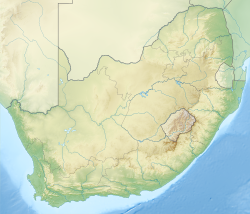Eye of Kuruman
| Eye of Kuruman | |
|---|---|

The „Eye of Kuruman“
|
|
| Location | South Africa |
| Coordinates | 27°27′48.6″S 23°26′10.68″E / 27.463500°S 23.4363000°ECoordinates: 27°27′48.6″S 23°26′10.68″E / 27.463500°S 23.4363000°E |
The Eye of Kuruman (Afrikaans: Die Oog) is a spring in the town of Kuruman (part of the Ga-Segonyana Local Municipality) in the province of Northern Cape, South Africa. One source states it is the largest known natural spring in the Southern Hemisphere., although the Te Waikoropupū Springs in Golden Bay, New Zealand has been reliably measured at an average flow some 60 times greater (14 m3/second).
The spring forms a small lake in the middle of the town, directly on the N14 road and is located in a fenced park. It has a daily flow of about 20,000 m³ of crystal-clear, potable water. Water from the spring supplies the town of Kuruman.
The town of Kuruman is located at the borders of the South Africa’s Northern Cape and North West province. The year 1895 was the only time in recorded history where the stream was constant throughout and moved from the eye, down the stream Kuruman river, Molopo River, Orange River and finally into the Atlantic Ocean. Originally, Tswana herders used the large spring as a water hole using pastoralism to limit output is small area. In 1885, the British classified the area as part of the Crown Colony of British Bechuanaland. This classification of land prohibited the Tswana people from using the stream for any purpose.The upper kuruman valley became a crown reserve and the Eye of Kuruman became the town site. Access to the valley became segregated by race in the twentieth century under the Union government. A modern irrigation project was operated by the municipality of Kuruman after 1918 and, in 1919 black cultivators were evicted from using water from the eye. However, black people continued to use the stream and moved 5 miles down the stream to Seodin. The water at the Seodin area had a much weaker stream making irrigation difficult for the Tswana people. The governments Department of Native Affairs drilled bore holes to assist the black farmers in 1940 however, this was still insufficient to sustain cultivation. In 1962, Apartheid legislation led to the forced removal of black people from Seodin. The ‘whites-only’ irrigation project never commercialised despite state aid.
...
Wikipedia

